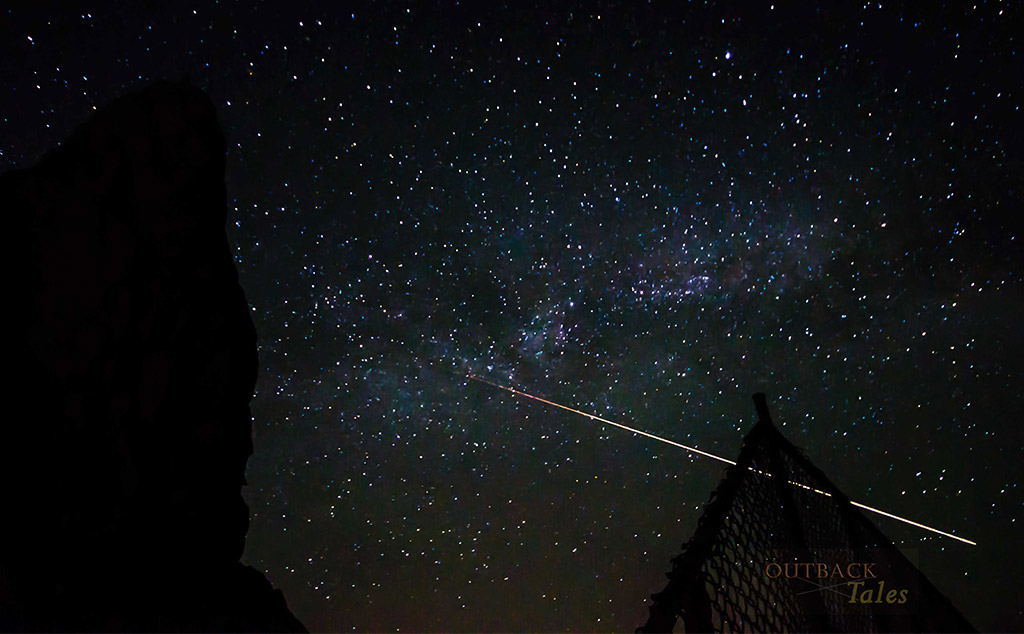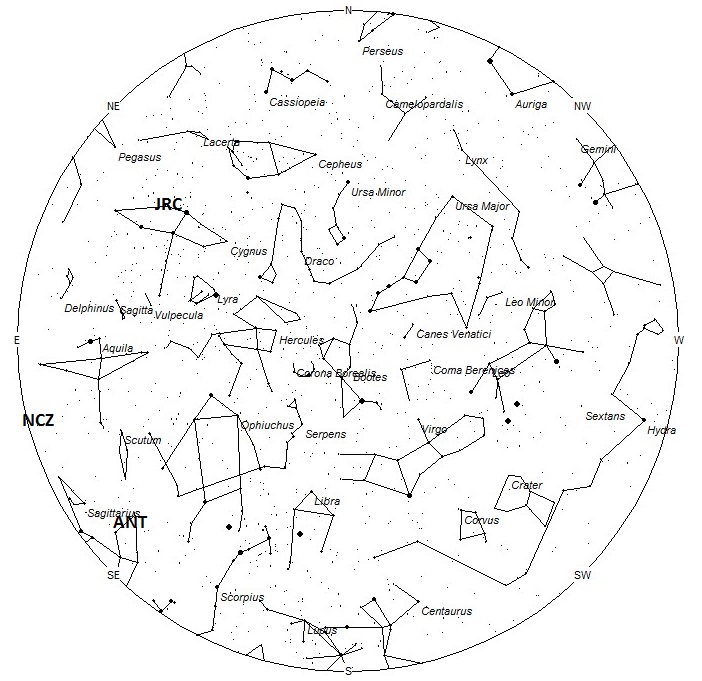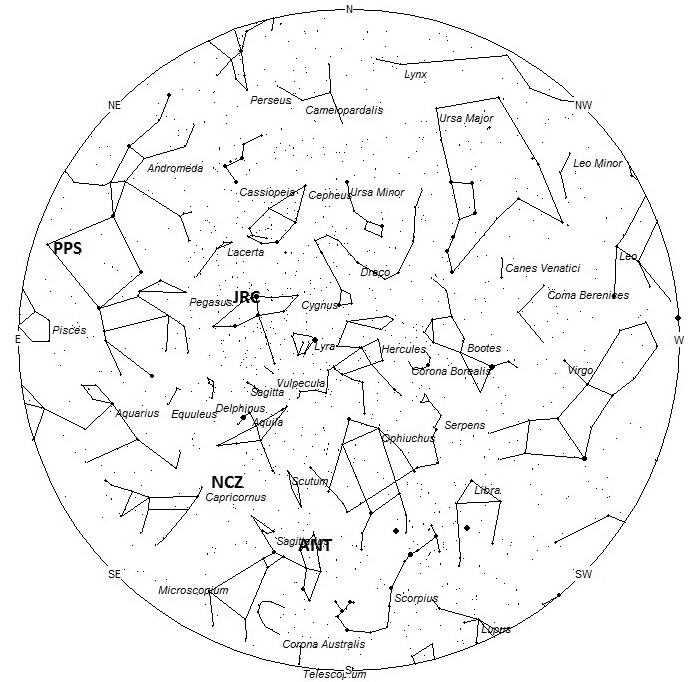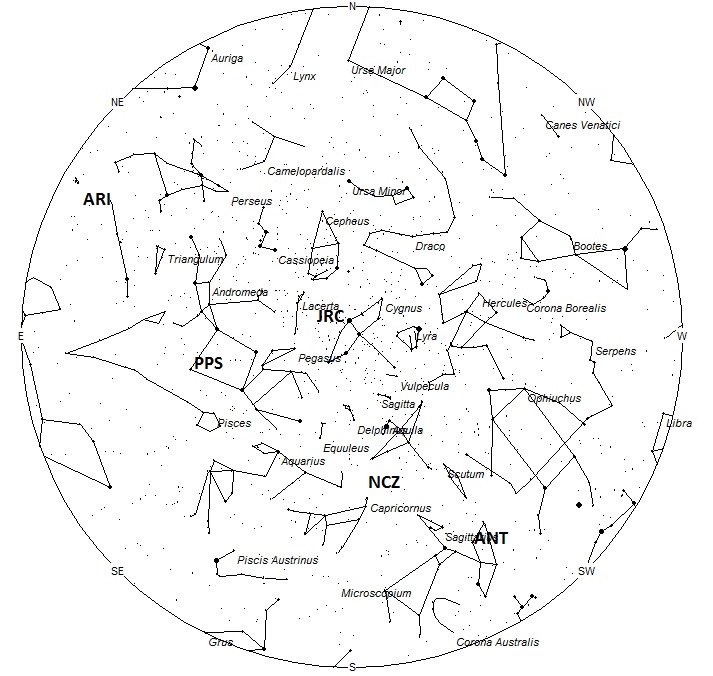
During this period the moon reaches its first quarter phase on Saturday June 11th. At this time the half-illuminated moon will lie 90 degrees east of the sun and will set soon after midnight for most locations located at mid-northern latitudes. As the week progresses the window of opportunity for viewing meteors in dark skies decreases with each passing night. Toward the end of the period the nearly full moon will lie above the horizon nearly all night long, making meteor observations difficult. The estimated total hourly meteor rates for evening observers this week is near 2 for observers located in the northern hemisphere and 3 for observers located in tropical southern locations (25S). For morning observers the estimated total hourly rates should be near 8 as seen from mid-northern latitudes (45N) and 12 as seen from tropical southern locations (25S). Evening rates are reduced during this period due to interfering moonlight. The actual rates will also depend on factors such as personal light and motion perception, local weather conditions, alertness and experience in watching meteor activity. Note that the hourly rates listed below are estimates as viewed from dark sky sites away from urban light sources. Observers viewing from urban areas will see less activity as only the brightest meteors will be visible from such locations.
The radiant (the area of the sky where meteors appear to shoot from) positions and rates listed below are exact for Saturday night/Sunday morning June 11/12. These positions do not change greatly day to day so the listed coordinates may be used during this entire period. Most star atlases (available at science stores and planetariums) will provide maps with grid lines of the celestial coordinates so that you may find out exactly where these positions are located in the sky. A planisphere or computer planetarium program is also useful in showing the sky at any time of night on any date of the year. Activity from each radiant is best seen when it is positioned highest in the sky, either due north or south along the meridian, depending on your latitude. It must be remembered that meteor activity is rarely seen at the radiant position. Rather they shoot outwards from the radiant so it is best to center your field of view so that the radiant lies at the edge and not the center. Viewing there will allow you to easily trace the path of each meteor back to the radiant (if it is a shower member) or in another direction if it is a sporadic. Meteor activity is not seen from radiants that are located far below the horizon. The positions below are listed in a west to east manner in order of right ascension (celestial longitude). The positions listed first are located further west therefore are accessible earlier in the night while those listed further down the list rise later in the night.
These sources of meteoric activity are expected to be active this week.
The center of the large Anthelion (ANT) radiant is currently located at 18:16 (274) -23. This position lies in western Sagittarius, 3 degrees south of the 4th magnitude star known as Polis (mu Sagittarii). Due to the large size of this radiant, Anthelion activity may also appear from the nearby constellations of Scutum, Serpens Caput, southern Ophiuchus, and southeastern Scorpius as well as Sagittarius. This radiant is best placed near 0200 local daylight saving (LDST), when it lies on the meridian and is located highest in the sky. Hourly rates at this time should be near 2 as seen from mid-northern latitudes and 3 as seen from tropical southern latitudes. With an entry velocity of 30 km/sec., the average Anthelion meteor would be of slow velocity.
The Northern June Aquilids (NCZ) were discovered by Zdenek Sekanina through his Radio Meteor Project at Havana, Illinois. These meteors are active from June 10-26, which maximum activity occurring on the 16th. The current position of the radiant is 19:37 (294) -11. This position lies in a remote area of southern Aquila near the Sagittarius border. The nearest notable star is 3rd magnitude Algiedi (Alpha Capricorni), which lies 9 degrees to the east. Rates, even at maximum, are expected to be less than 1 per hour. With an entry velocity of 41 km/sec., the average Northern June Aquilid meteor would be of medium speed.
The June Rho Cygnids (JRC) is a shower of short duration discovered by Damir Šegon and associates of the Croatian Meteor Network. These meteors are only active from June 14-16, with maximum activity occurring on the 14th. The radiant position at maximum lies at 21:22 (320) +45. This area of the sky lies in northeastern Cygnus, 4 degrees west of the 4th magnitude star known as rho Cygni. These meteors are best seen near during the last dark hour of the night when the radiant lies highest in a dark sky. These meteors are better seen from the northern hemisphere where the radiant rises higher into the sky before the start of morning twilight. Hourly rates, are expected to remain less than 1. With an entry velocity of 48 kilometers per second, a majority of these meteors will appear to move with medium velocities. This shower is synonymous with shower #521 JRP in the IAU Meteor Catalog.
The Pi Piscids (PPS) were discovered by Dr. Peter Brown in his meteoroid stream survey using the Canadian Meteor Orbit Radar. This shower was later verified by Dr. Peter Jenniskens and David Holman using data from the CAMS network in northern California. These meteors are active from June 11 through July 25 with maximum activity occurring on July 1st. The current position of the radiant is 00:00 (000) +18. This position actually lies in southeastern Pegasus, 4 degrees northwest of the 3rd magnitude star known as Algenib (Gamma Pegasi). Rates are currently expected to be less than 1 per hour no matter your location. With an entry velocity of 68 km/sec., the average Pi Piscid meteor would be of swift speed.
The radiant for the Daytime Arietids (ARI) only lies 45 degrees west of the sun. Therefore these meteors can only be seen between the time the radiant rises and dawn. This is a small window of opportunity that lasts for about an hour before the break of dawn. Maximum activity for this shower was expected on June 7th. The current position of the radiant is 03:16 (049) +24. This position lies in eastern Aries, a little more than 5 degrees west of the naked eye open star cluster known as the Pleiades or 7 Sisters. Despite being a strong source of meteors, visual members of this shower are rare due to the low altitude of the radiant. If this radiant was better placed in the sky it would rival the better known Perseids of August. These meteors are the strongest source of radio meteors for the entire year. With an entry velocity of 42 km/sec., the average Daytime Arietid meteor would be of medium speed.
As seen from the mid-northern hemisphere (45N) one would expect to see approximately 6 sporadic meteors per hour during the last hour before dawn as seen from rural observing sites. Evening rates would be near 1 per hour. As seen from the tropical southern latitudes (25S), morning rates would be near 9 per hour as seen from rural observing sites and 2 per hour during the evening hours. Locations between these two extremes would see activity between the listed figures. Evening rates during this period are reduced due to moonlight.
The list below offers the information from above in tabular form. Rates and positions are exact for Saturday night/Sunday morning except where noted in the shower descriptions.
| SHOWER | DATE OF MAXIMUM ACTIVITY | CELESTIAL POSITION | ENTRY VELOCITY | CULMINATION | HOURLY RATE | CLASS |
|---|---|---|---|---|---|---|
| RA (RA in Deg.) DEC | Km/Sec | Local Daylight Saving Time | North-South | |||
| Anthelions (ANT) | – | 17:48 (267) -23 | 30 | 02:00 | 2 – 3 | II |
| Northern June Aquilids (NCZ) | Jun 16 | 19:37 (294) -11 | 41 | 04:00 | <1 – <1 | IV |
| June Rho Cygnids (JRC) | Jun 14 | 21:22 (320) +45 | 48 | 06:00 | <1 – <1 | IV |
| Pi Piscids (PPS) | Jul 01 | 00:00 (000) +18 | 68 | 08:00 | <1 – <1 | IV |
| Daytime Arietids (ARI) | Jun 07 | 02:48 (042) +23 | 42 | 11:00 | <1 – <1 | IV |
 American Meteor Society
American Meteor Society



I saw a shooting star tonight on June 18, 2016 around midnight in Columbia SC.
We saw SOMETHING last night around 11 p.m. EST and I don’t think it was a meteor shower. We are in Louisville KY and at the NE end of the county.
It looked like one shooting star– moving VERY rapidly. Then about 50-60 other stars chasing right behind it. They did not drop below the horizons, but were moving across as an aircraft would. Very rapid. Looked like a pack of moving stars.
Nothing in our area about meteors or any other night type anomalies… any thoughts as to what this might be?
Hey Angie did you see this Friday June 17th? I saw a shooting star, at about 10:45pm from Erlanger Ky. Craziest thing I’ve ever seen! Very beautiful and was over in about 5 seconds.
On July 10, 2016, my wife and I were headed northbound on highway 54 coming back from a trip at 11:00am CDT 20-30 miles outside of Dalhart, Tx. We saw what was a blue green light pass across the sky very rapidly like some sort or laser maybe a shooting star never seen one in the day don’t know what it was exactly but was very interesting